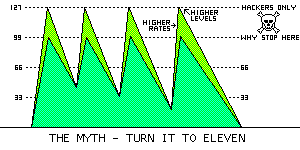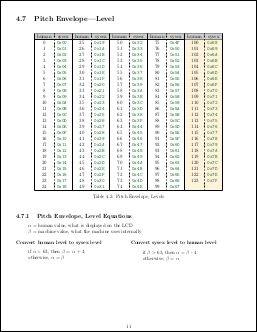The Myth
2012-06-30
There is a particular persuasive myth that has been floating around Casio CZ communities for a long time. In a nutshell, the idea is that the limitations of the LCD display prevent envelope values greater than 99, but if you hack the sysex messages you can get values as high as 127! And furthermore, that all your sounds are deeper, more excellent, and richer when this happens.
Most people in the world will not be interested in whether this is true or not. If you are one of the few who are interested in this myth, you owe it yourself to download this document I have prepared. It is a PDF file that contains the tables and equations that translate between human and machine values. These are essential for understanding the truth of this myth.
Before starting, please read up about the difference between human values and machine values for envelope data.
Why The Myth Is Persuasive
It is easy to observe that the maximum value for envelope data, both in the Casio documentation and when you program the machine from the front panel, is 99. This number makes people suspicious.
First, the number conveniently stops at the last two-digit number that exists in decimal integer counting.
“Perhaps they stopped at 99 solely because they didn't have room on the LCD to put another number!”
Second, if you tinker around with system exclusive data at all, you will know it is a binary format, and you have to use a hex editor to work with it. Numbers that make sense in hexadecimal are 8, 16, 32, 64, 128, 256, and so on.
“Perhaps the true limit is a number that makes sense in hex, like 127!”
Those two ideas are the kernel of the myth, and it builds from there. It goes like this:

“Casio capped the envelopes at 99, but only when you program using the panel, because they were catering to a western audience and the LCD display was limited. But if you know how to edit the sysex files, you can take the values all the way to 127. And when you do, everything sounds sweeter and sharper because you are finally getting out of the muddy middle range and into SWEET CLARITY!”
I am surely exaggerating the story, so I apologize for that. I don’t mean any insult by it. I agree the story is persuasive. To make it even more persuasive, there are other confirmed easter eggs in the sysex data.
Ways The Myth Is Not True
There are a number of important things to understand, to make sense of this idea.

- The number you see on the front panel, for example 99, is the
human value, which is for display. The synthesizer really wants the
machine value when creating sounds.
(More info.) - The machine value cannot be greater than 0x7F,
or 127.
(More info.) - The human values are mapped to the machine values by discrete
functions.
(More info.) - In four out of six cases, the human value 99 is directly mapped to the machine value 0x7F. For four out of six cases, therefore, there are no values beyond 99, and you are already getting the full range from your synthesizer.
If you want to see for yourself the fact that the majority of envelopes have the maximum human value (99) mapped to the maximum machine value (0x7F), then download the PDF that I prepared and linked above. It contains nicely formatted tables and equations that demonstrate the mapping of human values to machine values.
If you don’t trust this document that I produced, you can still download the original Casio CZ-1 Midi Specification from somewhere. Compare its tables to the ones I have created. They will be very similar, but harder to read and with a few mistakes.
Ways The Myth Is True
There are two cases where there is some truth to the myth, where there are potential extra values beyond 99. It remains to be seen whether these extra values do anything useful.
Pitch (DCO) Envelope Level
Pitch envelope levels seem to be able to go up to a human value of about 123 before they reach the machine value max of 0x7F.
That means the pitch envelope can potentially go to higher levels than previously possible. I have not done any tests to see if this is beneficial or even audible. Tests TBD.
Amplitude (DCA) Envelope Rate
Amplitude envelope rate can go up to about 106 before reaching the maximum machine value. This is not a very big extension beyond 99.
An amplitude envelope rate of 99 is already a sharp attack or decay, perhaps the sharpest that is needed. If that value is extended to 106, that would mean there could be an even sharper attack or decay.
I have not tested if these values are usable. And if they are usable, is the difference in attack rates observable? Tests TBD.
 kasploosh.com
kasploosh.com
